Growing up in Toronto, every year I counted down the days to my annual summer vacation to interior British Columbia. Floating on pristine mountain lakes was paradise to a city person like me. The locals, I quickly learned, had a different vision of paradise—a sleepy little village on the west coast of Vancouver Island called Tofino.
While Canadians mainly find Tofino alluring because it’s one of the few spots in the country where you can surf—ancient rainforests, sprawling beaches, and a mild year-round climate (by Canadian standards) set the backdrop for other outdoor activities too, like hiking, kayaking, and whale-watching. With eclectic fish-to-fork restaurants and a diverse art scene, local chefs and artists have been expanding Tofino’s surf town reputation to attract a wider crowd. And it’s working—Tofino’s population can reach 50,000 in the summer, compared to the 2,000 people that reside there year-round.
The summer rush makes it nearly impossible to experience the laid-back, surf town vibe that made Tofino the hotspot it is today. So I chose to visit in November, to fully embrace the slow pace. Better yet, by having so much space and time to myself, I was able to fully take in the diverse natural surroundings—from the towering cedars blanketed in fog to the dramatic sunsets over the misty shores.
But first, getting there. Tofino’s abundant natural wonders are largely due to its remote location in the Clayoquot Sound UNESCO Biosphere Region, an hour-long plane ride from Vancouver, British Columbia. Since catching a flight to Tofino felt too rushed after flying across the country, I spent a night in Vancouver, arguably Canada’s most picturesque city. One night at the chic DOUGLAS hotel was just enough time to take in the sparkling skyline, unwind in a massage at the Spa by JW Vancouver, and savor a chocolate croissant at the bright and airy Honey Salt restaurant on the ground floor.
The most popular airline to get you to Tofino is Pacific Coastal Airlines, but make sure you go to the South Terminal of Vancouver Airport (a separate building just south of the main airport). If traveling in the fall, expect to get a head start on Tofino’s slow pace at the airport—my flight was an hour delayed due to fog in Tofino, something I learned is very common. My plane had an open cockpit and about 12 seats total, so if you’re afraid of flying, you might want to travel to Tofino by car and ferry instead. For me, the 45-minute flight was worth the nerves for the breathtaking views of verdant Vancouver Island meeting the vast Pacific Ocean.
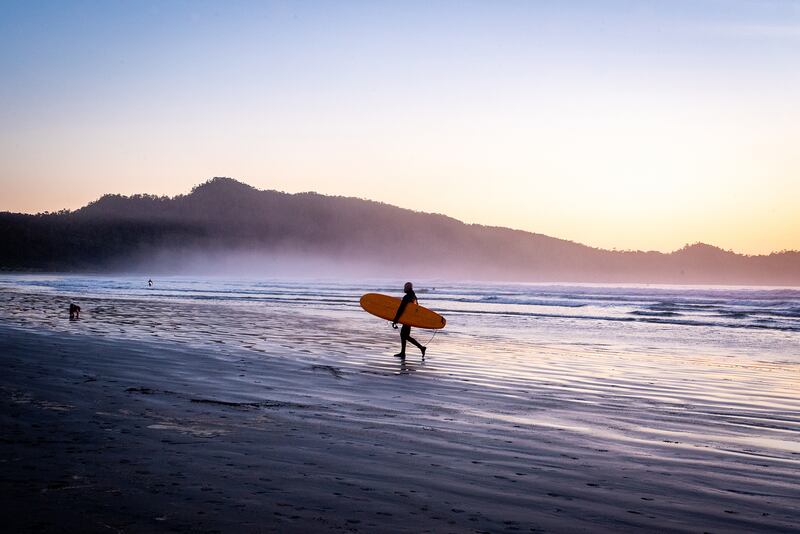
A surfer at Pacific Sands Beach Resort.
Anna HainesWhile I just missed my chance to see the whales (whale-watching runs from March through October), I heard November was the best time for photographers to visit because of the epic storms. Having mentally prepared for rain (especially after our fog-related delay), I was surprised to see sunny skies upon landing, and every single day afterward. If you’re visit in the off-season, don’t expect to be so lucky. Thankfully, accommodations like Pacific Sands Beach Resort are prepared for rainy days with fully equipped, apartment-style rooms with giant windows overlooking the ocean, perfect for storm-watching cozied up next to your own fireplace. The complimentary hot chocolate and extensive DVD collection in the lobby—from which I grabbed a few discs to watch in my room for nostalgia’s sake—almost made me wish it was raining. Still, I was more grateful for the too-good-to-be-true weather because it allowed me to explore the property’s 41-plus acres, including its 1,500 feet of undeveloped coastline and deserted trails (which I largely had to myself).
Nature is certainly Tofino’s main draw, and the region’s diverse ecosystems also make it a playground for chefs. No surprise, then, that Tofino has a small-but-mighty culinary scene. Few restaurants exemplify the creativity better than Wolf in the Fog, where smoked oysters are doused in truffle oil and fried in potato strings, and charcuterie looks like “seacuterie”: a trio of halibut-wurst, charred octopus, and lingcod pastrami. With driftwood decor and a broken surfboard hanging on the wall, the dimly lit room perched over a surf shop attracts locals and visitors alike for its intimate, laid-back vibe.
A few steps from Wolf in the Fog, you’ll find another local favorite—Rhino Coffee. Donuts and coffee are their staples, and I savored both for breakfast every day while watching the surfers catch the morning waves from my hotel room patio. The full-body wetsuits gave me the impression the water must be freezing, but I was surprised to learn that the ocean can actually feel warmer in the fall and winter because of the cooler air temperature. Still, I was hesitant to surf myself, mainly because of a surfing accident a few years ago that left me concussed and terrified of the waves. But if I was going to get back on the board anywhere, it would be here, with Surf Sister. The female-owned surf school, conveniently run on Pacific Sands Beach Resort, was created to encourage women to feel less intimidated by surfing, amid a largely male-dominated industry.
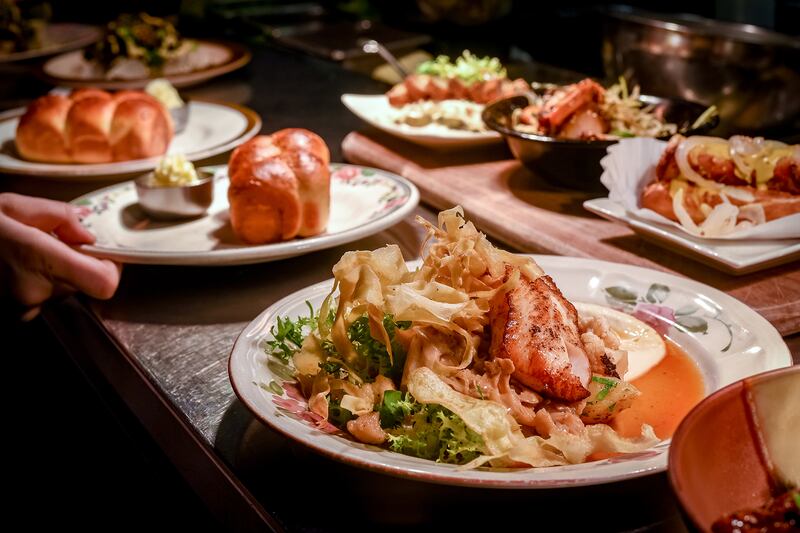
Dishes at Wolf In The Fog
Anna HainesWhether or not you brave the waves, do eat lunch at Surfside Grill—a surf shack located just off the beach at Pacific Sands that makes for a relaxed refueling spot. Everyone around me had salads, but I opted for a smoked salmon cheddar burger, powering up for an afternoon walk through Tofino Botanical Gardens with environmentally-focused tour company Clayoquot Wild (they offer other tours like whale-watching and fishing, too). Given Tofino’s slow pace, I should’ve known it would be less of a vigorous walk and more of a gentle stroll. I expected my guide—81-year-old First Nations elder Moses Martin—to fill the time with lessons on the Indigenous perspective of the surrounding forest. Instead, there were many long silences. As a Torontonian, this made me anxious; I felt rushed to learn. But after an hour, I realized the Indigenous learning Martin shared was to simply be in nature, expressed not through words, but through him leading by example.
Still, I hadn’t soaked in enough of Tofino to kick the city person out of me. When I got back to Pacific Sands, I wanted to check out the 12-kilometer multi-use path that connects the resort to Tofino. The resort rents bikes but I decided to walk instead. I soon regretted it. I didn't realize how early the sun sets in November and I didn’t know that the path isn’t lit, so within 10 minutes I could hardly see more than one step ahead of me. The majestic forest beside me transformed into a dark abyss filled with potential danger. I found refuge in Chocolate Tofino, just off the highway. As I entered the quaint shop, the sweet smell of chocolate blanketed me in comfort. Next door was another popular Tofino spot I’d been wanting to check out—Hotel Zed. With the world’s first bike-through lobby, a secret arcade, and mini disco, the retro hotel is the only of its kind in Tofino, and was just the distraction I needed.
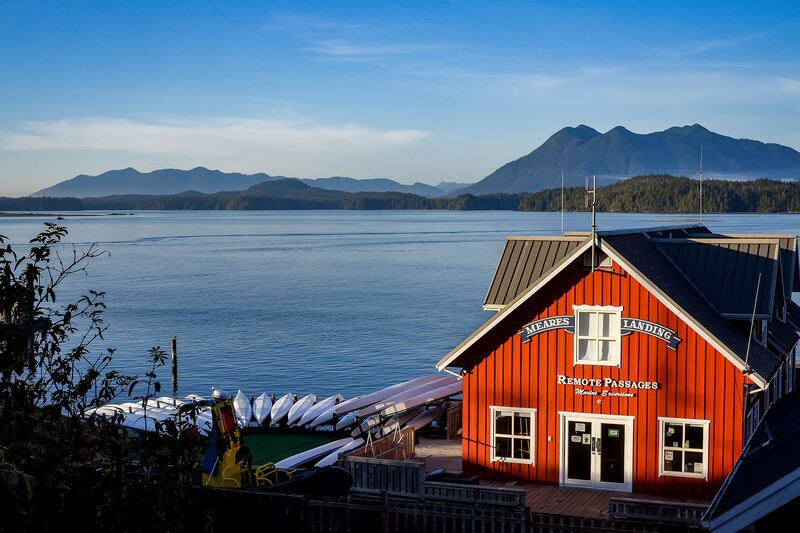
Tofino Harbor.
Anna HainesOf all the natural wonders in Tofino, I was most drawn to the ocean. Slow mornings were spent being mesmerized by the misty waves either from my room or the nearly empty beach. But I was yearning to get on the water. So I took a boat ride with Stevie Dennis, the Indigenous founder of seaweed-and-seafood company Naas Foods. As he heaved a giant kelp plant onto the boat and sliced a blade for me to eat, he told me how visitors can give back to local First Nations communities by eating at restaurants to which he’s supplied Indigenous-harvested seafood and kelp—like ROAR and The Pointe Restaurant.
With a new impression of Tofino as a tight-knit community, I docked at the harbor eager to explore the town, especially since my hotel was 4 miles away (this is the case for most of the nicer accommodations). I checked out Roy Henry Vickers Gallery for First Nations art and Mark Hobson Gallery for nature paintings. But my favorite art was actually found in local shops, like The Factory, which prints and frames the work of local photographer Kyler Voss right behind the cash register. I also lingered in two female-owned shops—Merge and Caravan Beach Shop—to admire their thoughtful curation of Canadian-made goods.
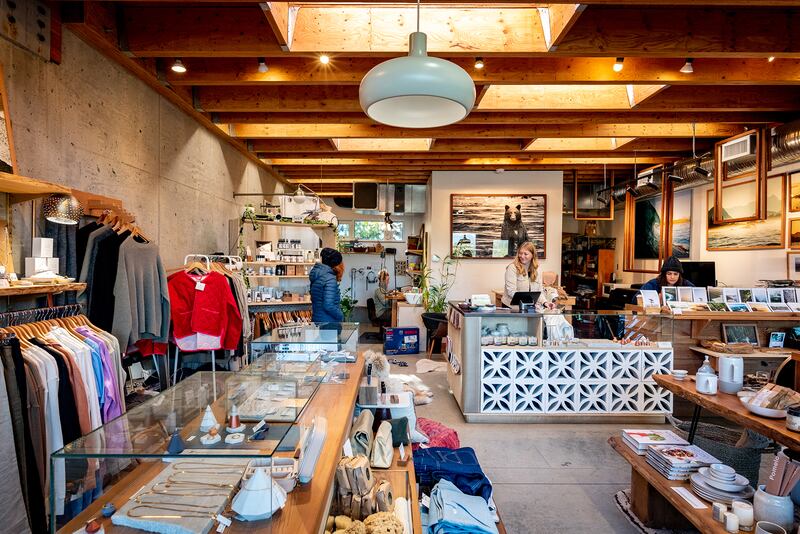
The Factory shop in Tofino.
Anna HainesThe least local experience I had during my time in Tofino was sitting in a Finnish-style, wood-burning sauna back at Pacific Sands. While Tuff City Saunas was inspired by the centuries-old Nordic tradition of hot and cold water therapy, the experience here is still made Canadian by replacing the requisite cold plunge pool with the Pacific Ocean. After 15-minutes in the wooden-barrel sauna, the cold water is a shock to the system, one I’m told relaxes muscles and tones the skin. If you’d prefer a more traditional spa treatment, the resort’s onsite spa—By The Sea Massage & Bodywork—offers a variety of massages in cozy treatment rooms.
While wellness treatments always help me unwind, what I found most relaxing about Tofino was that I didn’t have to travel far to taste a wide variety of food. For my last dinner, catering company Taste of Tofino came to me and prepared a multi-course feast in one of Pacific Sand’s larger suites (they’re planning to open their own café at the resort soon). Breakfast the next day was only a few steps away from my room too. My usual morning routine of watching the surfers from my patio got an upgrade to floor-to-ceiling views of the ocean from Long Beach Lodge’s The Great Room restaurant next door. As I inhaled the salty ocean air on the balcony after a hearty brunch spread of lox bennies and waffles, I realized I’d finally eased into Tofino’s calm energy, right before heading to the airport.
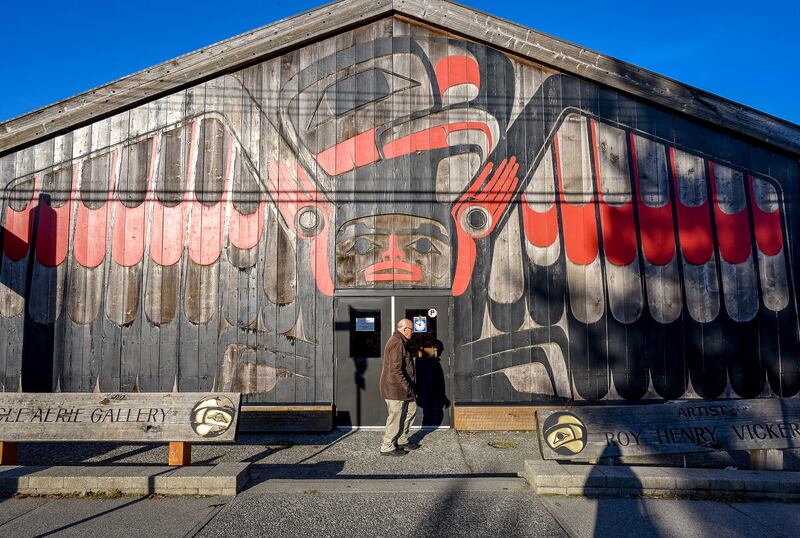
Roy Henry Vickers Gallery in Tofino.
Anna HainesDetermined to not undo any of the relaxation I’d found in Tofino, I broke up the journey home by spending the night at Fairmont Vancouver Airport. Located right above the departures terminal, I rolled out of bed and moseyed over to security, a fitting end to a trip that taught me the value of slowing down. If warm weather is your priority, join the crowds in the summer, but to discover Tofino’s real magic, go when it’s slow.






